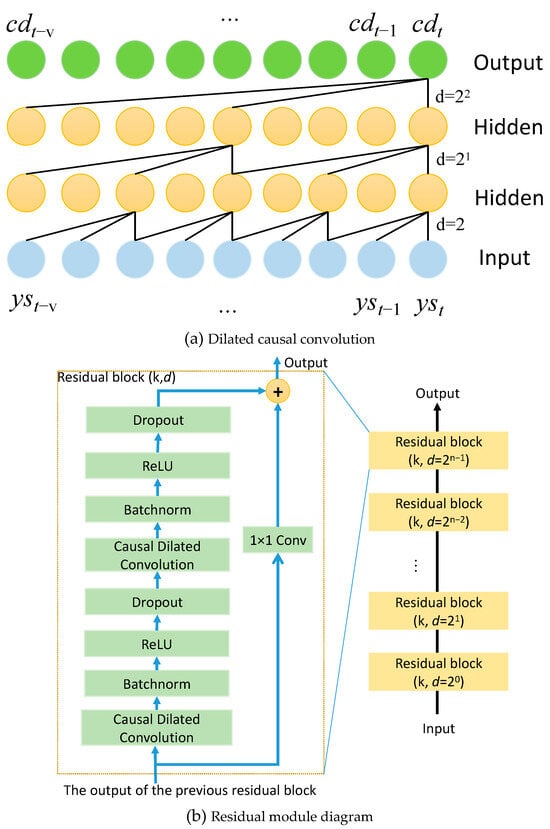1. Introduction
In the context of the global pursuit of carbon neutrality and sustainable development, the establishment of zero-carbon intelligent buildings has emerged as a significant prerequisite and an inexorable trend for propelling modern buildings to transform and evolve in a green and sustainable manner [
1,
2]. As a crucial aspect of intelligent buildings, the intricate and fluctuating building loads exert a profound influence on their operational management, maintenance, and refurbishment, as well as architectural planning and design. With regard to the operation, maintenance, and planning of buildings, it is essential to conduct load modeling, prediction, and optimization tasks with multiple time scales and high precision.
In the past few decades, scholars at home and abroad have conducted a large number of research works in the field of load forecasting. Load forecasting models can be roughly divided into three categories: mechanism models, statistical models, and artificial intelligence models. The mechanism models are constructed based on the principles of energy conservation, heat transfer, thermodynamic laws, and fluid mechanics. They use modeling software such as TRNSYS [
3], DeST [
4], and EnergyPlus [
5] for simulation. Such models have the significant advantage of high interpretability. However, they have strict requirements for data quality and integrity. The modeling and calculation are rather difficult, and they are affected by non-ideal factors in the actual system. Therefore, continuous modification and calibration are needed to ensure their accuracy. The statistical models mainly rely on time series analysis, including the exponential smoothing method [
6], autoregressive integrated moving average (ARIMA) model [
7], Kalman filtering method [
8], multiple linear regression method [
9], etc. Although the above models have simple network structures and relatively fast training speeds, when dealing with large datasets, their capabilities are insufficient to fully capture the nonlinear characteristics in multivariate time series.
Compared with statistical models, artificial intelligence methods have demonstrated superior prediction performance [
10,
11]. They have become the mainstream technologies in load forecasting and have achieved remarkable results in this field. Researchers have widely applied these methods to handle load forecasting tasks. For example, Talmannini et al. [
12] applied artificial neural networks (ANNs) to predict the electricity consumption of 709 households in Ireland, and the results showed that artificial neural networks were significantly better than the autoregressive integrated moving average (ARIMA) method. Hu and Wei [
13] proposed a building cooling load forecasting method that combined meteorological information with the backpropagation neural network (BP). By inputting data such as meteorological information and electrical loads, it predicted the future hourly building cooling loads. Chen et al. [
14] developed a support vector machine (SVM) electrical load forecasting model combined with meteorological information and predicted the electrical load of an office building by inputting the ambient temperature of the previous two h. These studies have already proved the advantages of artificial intelligence methods in nonlinear modeling, adaptive ability, and multivariate integrated processing. However, these methods are usually not optimized for the historical dependence in time series data. In fact, the historical information of loads has important reference value for load forecasting. In contrast, the long short-term memory (LSTM) neural network, due to its unique feedback mechanism, can effectively capture the historical dependence in time series, thereby improving its adaptability and flexibility in load forecasting tasks and further enhancing the accuracy and reliability of the prediction [
15,
16,
17].
Man et al. [
18] applied the LSTM to the prediction of building electrical loads. By inputting the load data of the previous 24 days, it could predict the load data for the next day. The results showed that the prediction performance of the LSTM model was better than that of the support vector machine. Zhang et al. [
19] utilized the LSTM neural network to conduct research on the short-term heat load of a heating station for the next day by inputting meteorological data and historical heat load data, proving that the LSTM was suitable for being applied to the heat load forecasting tasks of buildings. Cordeiro-Costas et al. [
20] summarized the load forecasting methods in recent years and compared them, including the random forest (RF), support vector regression (SVR), extreme gradient boosting (XGBoost), multi-layer perceptron (MLP), LSTM, and time convolutional network (CNN). The results indicated that the LSTM had the optimal prediction performance. However, cold, heat, and electrical loads themselves have various complex time-varying patterns, and it is difficult to accurately capture such highly complex time-dependent relationships merely relying on the LSTM.
With the continuous development of artificial intelligence, many scholars have begun to explore hybrid models to improve the performance of LSTM in load forecasting. Zang et al. [
21] proposed to strengthen the ability of LSTM to capture long-term dependencies by using the attention mechanism for the day-ahead prediction of residential loads. Sonder et al. [
22] proposed combining the CNN with LSTM, using the CNN to extract weather-coupling features and using LSTM to capture long-term dependencies, and predicting the heat load in the next 24 h by inputting the features of weather numerical forecasts. The results showed that the CNN-LSTM performed better than the SVM, MLP, RF (random forest), extra tree regression (ETR), and gradient boosting regression (GBR) models. Kim et al. [
23] proposed to conduct similar day analysis using future weather forecasts and predict the heat load on a 24 h scale in the future by inputting historical heat load data and temperature. The results showed that the proposed CNN-LSTM model was significantly better than models such as LSTM and CNN. Ullah [
24] comprehensively reviewed the advantages and disadvantages of load forecasting methods, including ARIMA, SVM, RF, MLP, and LSTM. After a detailed analysis, Ullah finally chose to combine CNN with LSTM and, by inputting information such as historical loads and dates into the constructed model, predicted the power load for the next 24 h. The results showed that the CNN-LSTM model has a relatively high prediction performance. However, all of the above methods focus on the prediction research of a single load, and most of them rely on meteorological data as the basis for prediction without recognizing the coupling relationship among loads.
With the development of load forecasting research, some scholars have begun to pay attention to the relationships among multiple loads. Peng et al. [
25] recognized the coupling relationship between heat load and electrical load and proposed to combine information such as historical multi-load characteristics to predict the heat load and electrical load of buildings. Jin et al. [
17] proposed using the LSTM model to conduct building energy demand and on-site power prediction by inputting data such as temperature, humidity, solar radiation, and historical loads. Song et al. [
26] proposed using the LSTM model to establish a multi-task learning model and predict the future multi-variable load situation by inputting the electrical loads and gas loads of three schools. Liu et al. [
27] established a multi-task learning (MTL) model based on LSTM and predicted the load for the next hour by inputting electrical loads and temperature loads. The results showed that the proposed method had a more accurate prediction effect than single models such as XGBoost, SVR, Decision trees, and Self-boosted. In order to better extract the features of multiple loads, Zhang et al. [
28] proposed combining the CNN and LSTM models to predict the comprehensive loads of cooling, heating, and electricity. By inputting the historical data of cooling, heating, and electrical loads, they predicted multiple loads for the next hour. The results indicated that the performance of the model considering the coupling of multiple loads was better than that of single-load prediction models. However, the study did not conduct research on the composite prediction scale.
Table 1 summarizes the comparison of the predictive performance of the models recorded in the literature.
It can be seen from
Table 1 that the CNN-LSTM model shows excellent performance in the load forecasting task. However, the CNN model mainly focuses on spatial local features and it is difficult for it to fully capture the long-term dependencies of time series data. The temporal convolutional network (TCN), as an improvement on the traditional CNN, is more suitable for being applied to load forecasting tasks through techniques such as dilated convolution and causal convolution. Li et al. [
29] applied TCN to the load forecasting task, and the results showed that the TCN model was more accurate whether in the case of inputting weather factors or not inputting weather factors.
The above-mentioned literature represents extensive research on load prediction, but there are still some issues that remain to be further explored. Firstly, the operation, maintenance, and planning of intelligent buildings require multi-load prediction models that can adapt to multiple time scales. However, few studies in the literature have simultaneously carried out comprehensive prediction research and analysis on cooling, heating, and electrical loads under different time scales. Secondly, there is relatively little prediction research in the existing literature when future weather forecast data are lacking. Given the complexity of obtaining hourly weather numerical forecast data, this limitation poses certain challenges to the wide application of load prediction models. Moreover, at present, the existing prediction models based on historical data still have some limitations in extracting time-dependent relationships. If the models fail to effectively capture sequence characteristics, resulting in a decline in prediction accuracy, they will directly affect the benefits of intelligent buildings.
Based on this, in the absence of future weather data and aiming at the prediction accuracy problem of the combination scale of multiple cooling, heating, and electrical loads, this paper proposes a multiple-load forecasting method that combines the temporal convolutional network (TCN), the long short-term memory (LSTM) network, and the self-attention mechanism. The contributions of this paper are summarized as follows:
In this paper, we propose a multi-time scale building multi-load forecasting model that does not rely on weather data. Upon recognizing the drawbacks of the CNN-LSTM hybrid model in load forecasting tasks, we suggest using the temporal convolutional network (TCN), which can capture the multiple coupling information among multi-loads more effectively, to replace the CNN. Meanwhile, we combine it with long short-term memory (LSTM) to extract the dynamic change features within time series. To prevent the loss of information in time series, we introduce the self-attention mechanism (SAM) to strengthen the model’s capacity for capturing time-dependent relationships, thereby achieving more accurate load forecasting.
Taking the cooling, heating, and power load demands of a particular building as the research object and based on the proposed TCN-LSTM-SAM load forecasting model, this paper has carried out experimental research on the cooling, heating, and power load forecasting across multiple time scales. The mean absolute percentage error (MAPE) and root mean square error (RMSE) are used to evaluate this model. Comparative experiments of different models have been conducted, and the results show that this model performs better than other models (LSTM, CNN-LSTM, and TCN-LSTM) in terms of both indicators. The comparative analysis of the prediction curves also reveals that this model has better anti-fluctuation performance in fitting performance and is more suitable for application in intelligent buildings.
4. Conclusions
In this paper, considering the situation of lacking future weather data, taking the cooling, heating, and electrical load demands of an industrial building as the research object, based on the proposed TCN–LSTM–self-attention multi-time prediction model for the building’s loads, prediction experiments on cooling, heating, and electrical loads were simultaneously carried out on the composite time scales of 1 h, 1 day, and 1 week. The following conclusions were drawn:
(1) It can be seen from the prediction curves that, only by utilizing historical load data, the TCN–LSTM–self-attention model proposed in this paper has good prediction effects in the prediction tasks on the composite scales of the building’s loads. This is because historical data contain the patterns and trends of the system operation within a certain period in the past, including periodic fluctuations, weather conditions, and other potential influencing factors. Based on these patterns and laws, the model can learn the characteristics of the system operation and predict, to some extent, the situations that may occur in the future.
(2) In the absence of future weather data, on multiple time scales, by comparing the prediction results of LSTM, CNN-LSTM, and TCN-LSTM, the results show that the TCN-LSTM model is superior to the LSTM and CNN-LSTM models. This proves that TCN has a more powerful feature extraction ability than CNN and also verifies the effectiveness of the method that uses TCN to extract the spatially correlated features among multivariate loads and combines it with LSTM to extract historical sequence information.
(3) In addition, the TCN–LSTM–self-attention model proposed in this paper has improvements compared with the CNN-LSTM model in predictions on multiple time scales. In the prediction tasks of cooling, heating, and electrical loads on the three prediction scales, the model proposed in this paper achieves an average improvement of 8.61% and 7.80% in the mean absolute percentage error (MAPE) and root mean square error (RMSE) indicators, respectively, compared with the TCN-LSTM model. Particularly, in the prediction task of cooling, heating, and electrical loads on the 1-week scale, the model proposed in this paper achieves improvements of 16.58%, 6.77%, and 3.87%, respectively, in the RMSE indicator compared with the TCN-LSTM model. This also proves that introducing the temporal self-attention mechanism into the TCN-LSTM model can strengthen the model’s ability to capture historical sequence information, help the model predict cooling, heating, and electrical load data more accurately, and make it more suitable for smart industrial buildings.
A limitation of the current study is that our proposed load prediction model primarily relies on historical load data. Although the self-attention mechanism enhances the model’s ability to handle uncertainties from weather changes, it may struggle to keep up with sudden and significant weather changes or load spikes due to new industries in industrial buildings, potentially reducing load prediction accuracy. Moreover, the model’s training hyperparameters are manually tuned, which is an area for improvement. Currently, the data are split chronologically at 70% (training), 15% (validation), and 15% (test), but the impact of different partitioning strategies on model performance has not been explored in depth. Given the importance of hyperparameter selection in prediction models and existing research on automatic hyperparameter setting, such as the Fully Adaptive Regression Model [
33] and EnergyDragon [
34], we plan to further explore this aspect in future research to unlock more of the model’s potential.



